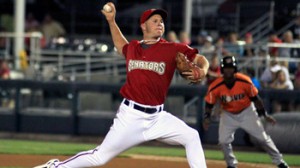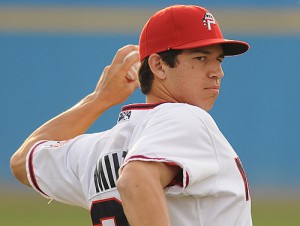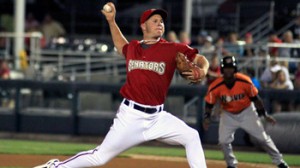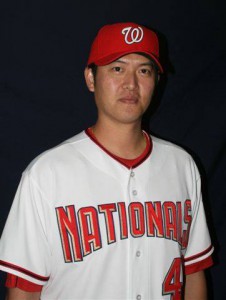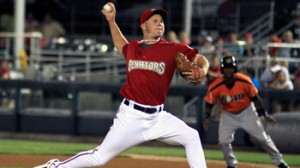
Danny Rosenbaum was your opening day starter, and best hurler of 2011. Photo Jeff Mankie/News & Messenger via insidenova.com
(3rd in a series; scroll back to earlier posts for AAA, AA reviews).
The defending Carolina League champs Potomac had some big shoes to fill, with a number of their impact players from last year departing and moving onwards and upwards. 2011 saw an interesting rotation full of question marks, and by the end of the season the rotation featured one of the franchise’s most important pitching prospects.
Here’s the status of the Potomac pitching staff at the end of the season (ages are as of 9/30/11)
- Rotation: Demny 22, Selik 24, Olbrychowski 25, Bronson (L) 24, Solis 23
- Bullpen: Smoker (L) 22, Nelo 25, Testa (L) 26, Wort 22, Holland 23, Frias 22, Holder 24
- Spot starts: Clegg (L) 24
- Promotions: CMartinez, RMartin, Lehman, Rosenbaum
- up-and-back: Bronson
- Demotions: Demmin, Weaver
- DL: EDavis 24
- Cut/released (spring training and/or mid-season): Fabian, Phillibaum, Dill, Beno, Caldera 25, Morrison 24
Potomac starters. The rotation started the season with Rosenbaum, Holder, Frias, Demny and Clegg.
- Danny Rosenbaum was your opening day starter, and easily your best starter in High-A this year. He put in 20 appearances (19 starts) and pitched to a 6-5 record, 2.59 era, 1.17 whip with 108/41 k/bb in 132 IP. The lefty looks like another in a long line of lefties this system is developing; not necessarily overpowering fastballs but pitches with guile and control. Much like Lannan, Milone or even teammate Solis, Rosenbaum will probably be a difficult pitcher to evaluate going forward, with scouts not knowing how to rate his ceiling as a starter. Outlook for next season: Rosenbaum was promoted at the very end of the season and had six very productive AA starts. He should start in Harrisburg in 2012.
- Trevor Holder has been fighting the “overdraft” label since his 2009 drafting as a 3rd rounder despite a less-than-stellar college career. After the Strasburg money outlay, many pundits thought that his drafting represented an “affordability” pick, and sure enough he signed as a college senior for far less than slot. Holder was given no less than 14 Potomac starts before mercifully being demoted to the bullpen, where he put in a few more relief appearances the rest of the season. Final season numbers: 3-8, 5.77 era. Outlook for next season: Holder should start 2012 in Potomac’s bullpen, and it would be the fourth year he’ll be in high-A. He’s officially in “organization guy” territory now, and unless he markedly improves soon he’ll be closer to a release than a future with this team.
- Marcos Frias is an interesting case; in 2010 he was awful as a starter for Potomac, yet he was given another shot in 2011. He got four early-season starts and wasn’t half bad (he had two good starts and one really bad one in April) and was demoted to the bullpen when Selik got promoted. Once he got to the bullpen? He was fantastic, posting a 1.67 era in 54 relief innings. The DSL graduate is still very young, and the Nats may have found a valuable bullpen arm. Outlook for next season: Frias should be in the AA bullpen, perhaps in the mix to be the closer.
- Paul Demny was the only hurler in the rotation who started and stuck in the rotation for the entire season, finishing the year with 26 starts, a 10-10 record and a 4.32 era. He’s still young (he’s in his fourth pro season and has just turned 22), but he’s also at the point in his pro career that he needs to start showing progress above the A level. As a JuCo signee he’s rule 5 eligible this off-season but there’s very little chance he gets selected (at least in the MLB phase), so the team has a bit more time to evaluate him. But 2012 is a make or break year for him. Outlook for next season: Perhaps he starts in high-A again, but he could be pushed up to the AA rotation depending on how the rosters shake out. I’m not sure he did enough to earn a promotion on performance in 2011, but a numbers game of recent rising college draftees may put him on the AA roster.
- Mitchell Clegg had nine mostly poor-to-incredibly bad starts before being demoted to the bullpen, at which point he had a couple of spot starts but worked mostly in the bullpen the rest of the year. On the year: 4-7, 5.50 era and he was equally bad out of the bullpen (starting split: 5.11 era, relieving split: 6.00 era). Outlook for next season: he’ll be lucky to make the 2012 Potomac bullpen, and I wouldn’t be surprised if he’s released after spring training.
- Cameron Selik earned a promotion to Potomac after five stellar outings in Hagerstown (where he gave up exactly one earned run in 29 innings) but wasn’t able to replicate that success in high-A. He gave the team 16 starts before being moved to the bullpen in August. As a starter in high-A he was 4-9 with a 4.57 era. Outlook for next season: he’ll be in the Potomac rotation, looking to improve his 2nd year at the level.
- Adam Olbrychowski was struggling during the first half as a middle-reliever in the Potomac pen, then was surprisingly inserted into the rotation, where he performed markedly better. He posted a 5.63ERA in 16 relief innings, then posted a 3.71 era in 15 starts during the second half. I may be wrong, but I believe he’s rule-5 eligible this coming off season, though his status as a mediocre-to-halfway decent right hander in high-A probably keeps him safe for the time being. Outlook for next season: good question. He’ll be 26 and in his 6th minor league season next year, but he clearly improved once he hit the rotation. I’d say he starts in the AA rotation with a short leash.
- Evan Bronson logged a lot of frequent flier miles this season; he was left in extended spring training, then joined up with Potomac a few cycles into the season. He lasted a few starts, got dropped from the rotation when Solis joined the team, made a quick appearance in AAA and a spot start in AA, then finished the season back in the Potomac rotation. Phew. All in all he posted a 5-5 record in high-A in 23 appearances and 12 starts. He was clearly better in relief than he was as a starter, often putting in long relief stints and holding down the fort. Outlook for next season: He’s put in good numbers in high-A two years running; time for him to move to AA. I’d guess he gets a look as a starter but serves as the long man/spot starter in AA.
- Sammy Solis had a slight injury in the spring, then started in low-A (a bit low for an accomplished college draftee of his stature). Once he made it to high-A though, he did not disappoint. In 10 starts he posted a 6-2 record with a 2.72 era, a 1.28 whip and had 53/11 k/bb in 56 1/3 innings. Whats really interesting about Solis is his splits; despite being a lefty he dominated right handed hitters, posting a 1.97 era split against them (albeit with a .260 BA against). Outlook for next season: Solis remains one of our better starter prospects though, and should advance quickly up the system in 2012. He will start in the AA rotation and may end the season in AAA.
- Erik Davis struggled in AA, earning a demotion to high-A, where he was even worse. 0-5 with a 6.75 era in six starts, ending the season on the DL (unclear if it was for a legitimate injury or a roster manipulation preparing the team for the playoffs). Outlook for next season: (from the AA post): he starts in the AA bullpen on a short leash.
- Other Starters of note (non-rehab): Alex Caldera had two awful starts and was summarily released in April. He was acquired for cash from Kansas City in late March and after his release picked up with the low-A affiliate of Florida.
Potomac Relievers:
- Pat Lehman was fantastic early on as the closer and earned a mid-season promotion. Outlook for next season: (from the AA post): he sticks in the AA bullpen, competing for the closer role.
- Hector Nelo took over as the primary closer after Lehman’s promotion and was similarly productive. He had a 2.40 era in 41+ innings and earned 18 saves. He really has turned around his career; getting released in April by Texas, signing with Washington two days later and looking like a new pitcher. He was a 25-yr old in high-A though; he’ll need to produce at the next level in 2012. Outlook for next season: AA bullpen in perhaps a setup role.
- Josh Smoker has remade his own career post arm injury, putting up great numbers in a later-inning relief mode. On the season he was 5-2 with a 2.31 era but more importantly 56 Ks in 50 innings. He’s rule-5 eligible but is in little danger of getting plucked away. Outlook for next season: AA bullpen.
- Joe Testa and Neil Holland were both excellent in middle-relief. Unfortunately Testa is way too old for high-A and may be considered the “extra guy” we got in the Ramos-Capps deal. Holland is much younger and pitched his way out of Hagerstown early. Outlook for next season: AA bullpen for both, though Testa may not be long for the organization, losing out in a numbers game.
- Rob Wort couldn’t follow up on his excellent 2010 numbers in Potomac and took a step back in 2011. He’s young though. Outlook for next season: he repeats high-A, again in the bullpen.
- Dean Weaver and Ryan Demmin both were demoted down to Hagerstown; we’ll cover them in the Low-A review.
- Other relievers with appearances: Rafael Martin was dominant and earned his promotion to AA. Kyle Morrison was released after just a few appearances early on. Carlos Martinez bounced around the organization and pitched a few ineffective innings for Potomac.
